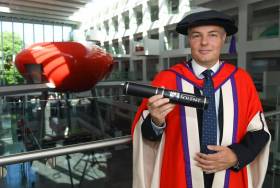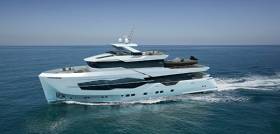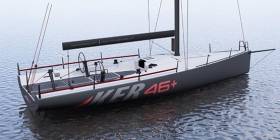Displaying items by tag: Jason Ker
Renowned Yacht Designer Jason Ker Awarded Honorary Degree
World-renowned yacht designer Jason Ker, has been awarded the honorary degree of Doctor of Maritime Studies by Solent University today.
Founder of Ker Yacht Design, an industry-leading company based in Winchester, Jason has forged a formidable reputation for racing yachts, later expanding into high performance cruising monohulls and catamarans.
Jason said: "I’m absolutely honoured to receive this award. Solent gave me a fantastic grounding in engineering that has allowed me to develop my skills and keep learning throughout my career. It’s amazing how the lessons I learned over 20 years ago still form so much of what I know today."
A passionate racing sailor from an early age and representing the UK at the senior level aged sixteen, Jason continued yacht racing during his time at Solent University, winning multiple National titles as a helmsman.
A diverse early career included building composite yachts near Sydney, conceptual R&D for fast car ferries in Tasmania, and multihulls and trimaran superyachts in the UK. Jason’s first design commission in 1997 quickly led to further commissions and the start of Ker Yacht Design.
Jason’s designs have had worldwide success, winning the hotly contested ‘big boat’ class at the UK IRC National Championships ten times, and consecutively for the last seven years.
A pivotal point in Jason’s career came with the design commission for a 55’ racing yacht named “Aera”. Its domination caused a stir, winning all seven of the inshore races of the 2003 Admirals Cup and the overall trophy for the 2004 Sydney to Hobart race.
Aged 33, Jason was recruited to set up and lead the design team for “Team Shosholoza”; the first South African America’s Cup Challenge, who were highly respected for their speed despite a relatively small budget. The key to Shosholoza’s remarkable speed was Jason’s ground-breaking approach relying on advanced computer simulation techniques.
"Everything is changing all time and what's cutting edge now will be antiquated before you know it!"
Continuous technological development has proved a hallmark of Jason’s career, not only during two further America’s Cups but also on his designs of racing yachts and successful projects in ship hull form optimisation.
Jason added: "My top tip for graduates today is to keep learning, and to stay on top of modern technologies - everything is changing all time and what's cutting edge now will be antiquated before you know it!"
Cruise the Planet on a Numarine Explorer Yacht For €7.9m
How about this for the last word in 'Explorer yachting'? If the world's your oyster, could you go too far wrong in this €7.9m stress–free cruiser? With a range of 3,000 nm at 12 knots it is literally possible to cruise the planet.
Following the signing of the contract of the new 24XP, Numarine – the Turkish high performance motoryacht shipyard based in Istanbul, with a range from 55' - 130' – has announced hull #1 of the all-new 32XP model has been sold to a Northern European client.
Lips are sealed but could he/she be a repeat Irish client?
The Numarine 32XP Series – together with 24XP and 40XP – will be a new line of Explorer series models.
Designed by Can Yalman the 32 metre yacht has accommodation for 12 guests – including a full width owners cabin.
32XP Hull #1 – Short technical sheet
Length Overall 32,5 m
Length on the Waterline 30,72 m
Beam (molded) 8 m
Draft (100% load) 2,1 m
Displacement full load 234 ton
Internal Tonnage under 300 GT
Passengers 12 (6 cabins)
Crew 5 (3 cabins)
Design Speed at Max (50% fuel &25% water) 14 knots
Design speed at Cruise 12 knots
Range 3000 nm
Fuel oil tankage 26.000 lt.
Fresh water tankage 3.000 lt.
Oily water tank 500 lt
Black water tankage 2.000 lt.
Grey water tankage 2.000 lt.
Gasoline tankage 150 lt.
Engines 2 x CAT C18 Acert C 715bhp @2100rpm
Generators
2 x 60 kW @1500 rpm, 220/400V three phase
1 x 22 kW @ 1500 rpm, 220/400V three phase
Hull Material Steel
Superstructure FRP Composite
Classification RINA : HULL ● MACH Y Unrestricted Navigation C for navigation without restrictions relating to recreational craft and for private use
A Dublin based Ker 36 'Keragous', a development of the successful Ker 39 "Flying Glove" is for sale through Leinster Boats Ltd yacht brokers.
With the same style of deck and interior as the Ker 39, this yacht was built with the aim of qualifying for the 2006 Commodore's Cup.
The yacht was built by Ritchie Faulkner Composites of the Hamble. According to broker Ronan Beirne of Leinster Boats, the design brief was for a 'true dual purpose yacht' with a modern comfortable interior that would lend itself to both racing and cruising while having performance and competitiveness under IRC to win on the race course.
Sleeps 6 in comfort for passage making and cruising and with additional berths for offshore racing.
The full advert giving a very complete inventory is on the Afloat boats for sale site here
Hull#1 of the new generation Ker46+ has been sold and will begin build later this month. The deal was signed last week at McConaghy's Zhuhai facility between the new owner Mr Shawn Kang and McConaghy's MD Mark Evans. Jason Ker was also on site for the signing, as was Wade Morgan who will act as the owners rep throughout the build.
The yacht will be raced by Shawn and his professional team, the yacht will be named Lighthorse, and fly the flag of the Royal Hong Kong Yacht Club (RHKYC).
Shawn said "I am excited we will soon be sailing this new and very fast, next generation Ker46+ . Having been sailing for many years our team is eager for more speed. With the new Ker46+ I believe team Lighthouse will be even more competitive on the water"
Mark Evans, MD of McConaghy said: "Shawn contacted us a few months ago about the Ker46, Jason and I had already spoken about updating the hull lines of the 46, so it was logical to offer the new package to Shawn. The yacht will have essentially the same deck as the first generation Ker46, but the hull shape and appendages are all new. So more tooling! But that's what it takes to stay ahead of the game, and that's what we do."
Jason Ker on the new design:
A lot has happened in the four years since we created the successful Ker46, of which four were built and raced successfully including class wins in the Sydney to Hobart race and many other race wins. Our continually improving optimisation technologies have been honed through various projects and it was clear that the time had come to bring out a new design. Replacing the Ker46 as our semi-custom offering in the size range, the Ker46+ uses as its generational baseline the heavily researched Ker40+ that came out guns-blazing in 2015 winning class in the Around the Island race on its first race outing and comfortably winning the first ever 'Fast 40' regatta.
Shape and Concept:
The Ker 46+ is significantly lighter than the previous generation, but its powerful hull form ensures excellent upwind and reaching performance. The hull shape is the product of an extensive formal optimisation involving large volumes of RANS CFD data, leveraged through use of Neural Networks and proprietary optimisation techniques. The optimisation process for the 46+ benefits from real data and feedback from our recent projects.
Structure:
Taking the structural optimisation to levels rarely seen outside of Americas Cup, the final lamination is the product of structural weight v stiffness optimisation, and the deflection of the shape under sailing loads is taken into account in the definition of the moulded shape. Construction is from pre-preg Carbon and carefully selected foams throughout; a large weight saving from the build method used on the infused Ker46 design.
The keel and mast support structure follows our tried and tested approach, built in the autoclave on machined aluminium moulds for reliability and accuracy.
Appendages:
An extensive keel shape optimisation has been carried out, achieving very significant section drag gains downwind without compromising upwind gains. These downwind gains have been used to increase the fin area, making the design easier to sail to its potential in variable conditions.
During recent years we have evolved our approach to keel fin structures, retaining our extremely cautious approach while taking advantage of extensive FEA structural optimisation and IRC's new freedom of keel fin material and processing selection to save considerable weight.
The rudder design uses an optimal blend of high modulus, intermediate modulus and standard modulus carbon fibre types to maximise its strength and stiffness within its design constraints, and is solid carbon right through its thickness in way of the critical lower bearing position.
Rig:
The rig aspect ratio is reduced compared to the previous 46, partly due to better sail depowering behaviour, reduced rig weight and better treatment by ORCi's aero model. The bowsprit length has increased significantly and the bowsprit design has been optimised for weight, stiffness, windage and reliability of installation.
Deck layout:
The 'coachroof' shape of the previous Ker 46 is retained, with its optimal jib sheeting arrangement on the apex of a long coachroof, however the jib tracks have been extended inboard to allow tighter sheeting angles. This arrangement allows for a more practical interior space for venturing offshore than the fully 'flat deck' arrangement that has become fashionable for inshore racing, but does so while actually saving weight through the incorporation of natural deck stiffeners into its shaping.
McConaghy Appoints Ancasta as Ireland Dealer
The initial focus of this new partnership is on the Ker 40; the Jason Ker Designed IRC racer. In addition to the Ker 40, Ancasta will also be promoting the McConaghy 38; an out and out lunatic machine that conforms to no rules and just goes fast upwind and downwind!
The Ker 40 is anticipated as being the next big step in IRC racing. It performs beautifully upwind whilst being exhilarating downwind. This fusion of TP52 inspired performance mixed with an ability to compete under IRC rating is a combination that offers something unique at a price which is very inclusive.
Nick Griffith MD of Ancasta commented: "We are all very excited about the Ker 40, the challenge under IRC has always been to produce a competitive boat under 50' that is also exciting to sail. I have been so impressed with Jason's efforts with the Ker 46 Tonnere and we see the 40 as the next step in that development. At last a full blown 40' race boat competing under IRC. Happy days indeed!"
Ancasta through its extensive network will be handling all the sales and marketing as well as providing the highest standard of after sales care and support. The first two Ker 40's coming to the UK will be based at Hamble Yacht Services in time for this seasons racing.




























































